Chicken Little (2005 film)
4.8 /10 1 Votes
36% Rotten Tomatoes Country United States | 5.8/10 IMDb 48% Metacritic Genre Animation, Adventure, Comedy Duration Language English | |||||||||||||||||||||||||||||||||
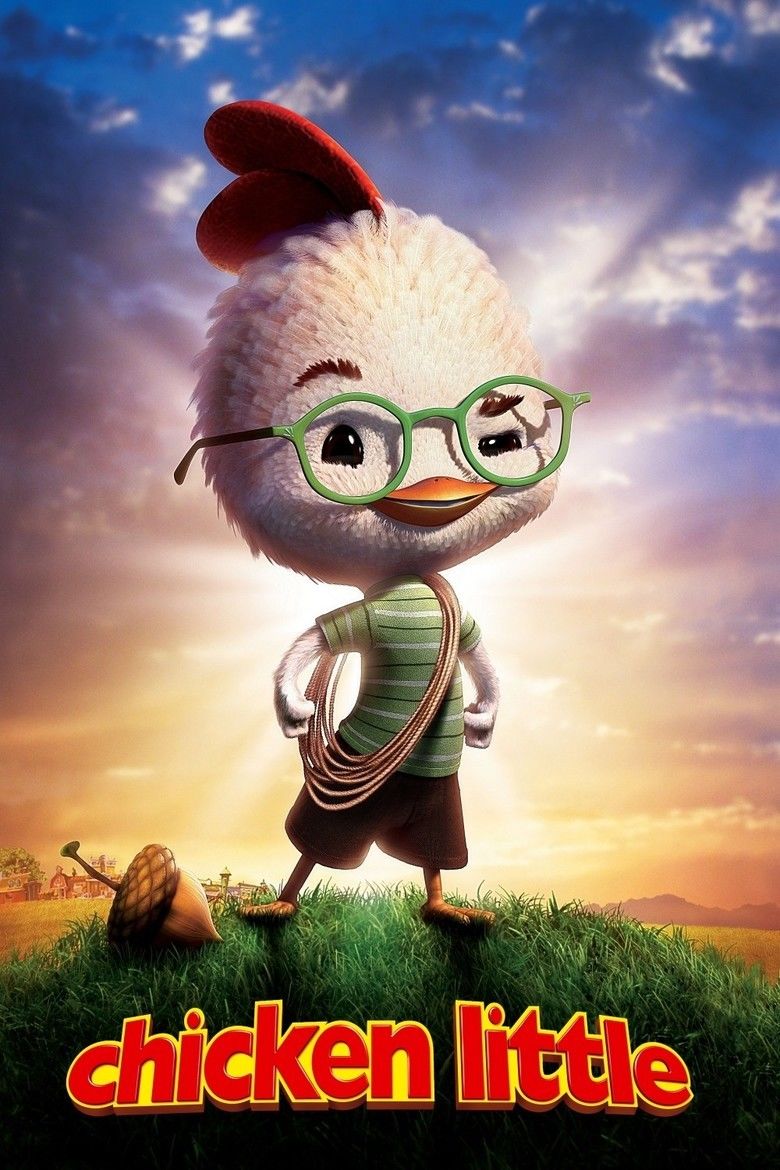 | ||||||||||||||||||||||||||||||||||
Release date October 3, 2005 (2005-10-03) (Los Angeles premiere)November 4, 2005 (2005-11-04) (United States) Writer Mark Dindal (story), Mark Kennedy (story), Steve Bencich (screenplay), Ron J. Friedman (screenplay), Ron Anderson (screenplay), Robert L. Baird (additional story material), Daniel Gerson (additional story material), Sara Parriott (additional screenplay material), Josann McGibbon (additional screenplay material), David Reynolds (additional dialogue), Sandra Tsing Loh (additional dialogue) Initial release November 3, 2005 (Malaysia) Film series Walt Disney Animated Classics Screenplay Steve Bencich, Ron J. Friedman, Sandra Tsing Loh, Josann McGibbon, David Reynolds, Sara Parriott, Ron Anderson Cast (Chicken Little (voice)), (Buck Cluck (voice)), (Mayor Turkey Lurkey (voice)), (Mr. Woolensworth (voice)), (Foxy Loxy (voice)), (Runt of the Litter (voice)) Similar movies E.T. the Extra-Terrestrial , Men in Black , Close Encounters of the Third Kind , Aliens , Independence Day , District 9 Tagline When it comes to saving the world, it helps to be a little chicken. | ||||||||||||||||||||||||||||||||||
Chicken Little is a 2005 American 3D computer-animated science fiction comedy film, produced by Walt Disney Feature Animation and loosely based on the original fable of the same name. The 46th Disney animated feature film, it was directed by Mark Dindal from a screenplay by Steve Bencich, Ron J. Friedman, and Ron Anderson, based on a story by Mark Kennedy and Dindal. The film is dedicated to Disney artist and writer Joe Grant, who died before the film's release.
Contents
- Plot
- Cast
- Writing
- Casting
- Animation
- Release
- Marketing
- Home video release
- Box office
- Critical reaction
- Soundtrack
- Video games
- Cancelled sequel
- References
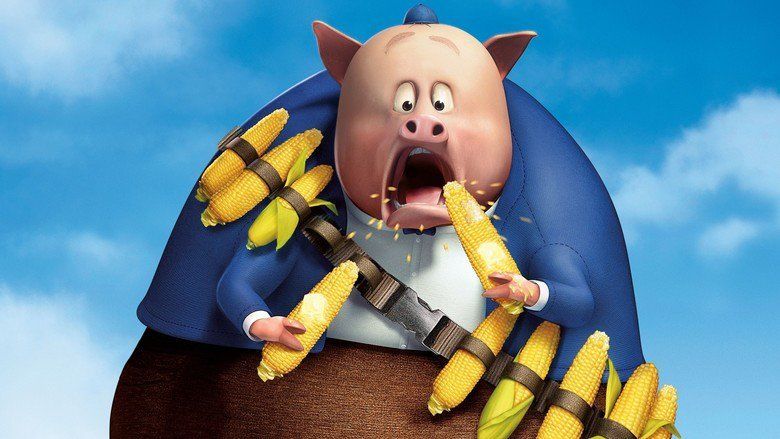
Chicken Little was animated in-house at Walt Disney Feature Animation's main headquarters in Burbank, California and released by Walt Disney Pictures on November 4, 2005, in Disney Digital 3-D (the first film to be released in this format) along with the standard 2-D version. It is Disney's first fully computer animated feature film, as Pixar's films were distributed, but not produced by Disney, and Dinosaur (2000) was a combination of live-action and computer animation.
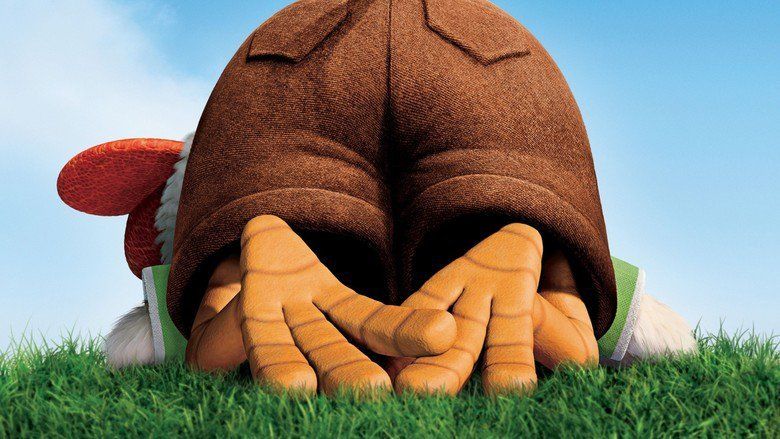
Chicken Little was Disney's second adaptation of the fable after a propaganda cartoon made during World War II. The film is also the last Disney animated film made before John Lasseter was named chief creative officer of Disney Animation and the last Disney film produced by Walt Disney Feature Animation before the studio was renamed Walt Disney Animation Studios. Chicken Little grossed $314 million worldwide.

Plot

In the small town of Oakey Oaks, Chicken Little rings the school bell and warns everyone to run for their lives. This sends the whole town into a frenzied panic. Eventually, the Head of the Fire Department calms down enough to ask him what's going on, and he explains that a piece of the sky shaped like a stop sign had fallen on his head when he was sitting under the big oak tree in the town square; however, he is unable to find the piece. His father, Buck Cluck, assumes that this "piece of sky" was just an acorn that had fallen off the tree and had hit him on the head, making Chicken Little the laughing stock of the town.

A year later, Chicken Little has become infamous in the town for being crazy. His only friends are outcasts like himself: Abby Mallard (who has a crush on him), Runt of the Litter (who ironically is extremely large), and Fish Out of Water (who wears a helmet full of tap water).

Trying to help, Abby encourages Chicken Little to talk to his father, but he really only wants to make his dad proud of him. As a result, he joins his school's baseball team in an attempt to recover his reputation and his father's pride, but is made last until the ninth inning of the last game. Chicken Little is reluctantly called to bat by the coach (even though the coach is certain that he will lose the game for them). Little is able to hit the ball and make it past first, second, and third bases, but is met at home plate by the outfielders. He tries sliding onto home plate but is touched by the ball. While it's presumed he lost the game, the umpire brushes away the dust to reveal Chicken Little's foot barely touching home plate, thus declaring Little safe and the game won; Little is hailed as a hero for winning the pennant.
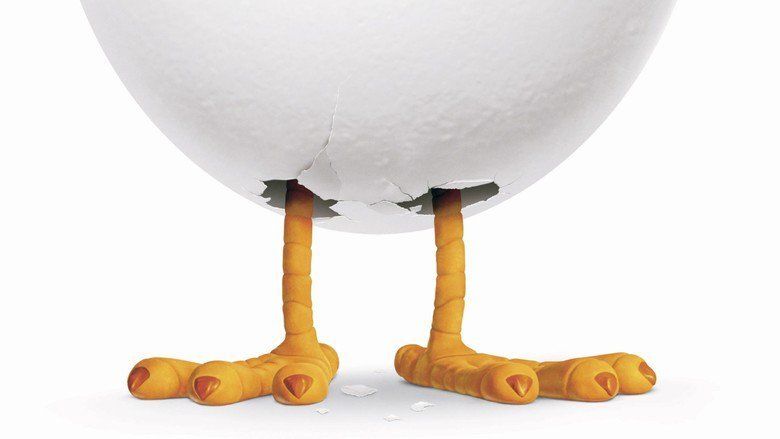
Later that night back at home, he is hit on the head by the same "piece of the sky" — only to find out that it is not a piece of the sky, but a device which blends into the background (which would thereby explain why Chicken Little was unable to find it last time). He calls his friends over to help figure out what it is.
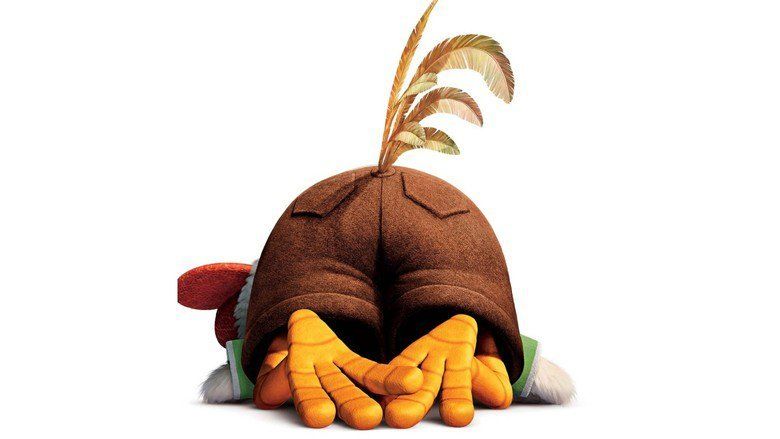
When Fish pushes a button on the back of the hexagon, it flies into the sky, taking Fish with it. It turns out to be part of the camouflage of an invisible UFO. Chicken Little manages to ring the bell to warn everyone, but the aliens see the crowds coming and manage to escape, leaving an orange alien child behind. No one believes the story of the alien invasion, and Chicken Little is ridiculed yet again... until the next day. He and his friends discover the orange alien, and a few minutes later a whole fleet of alien ships descends on the town and start what appears to be an invasion. The invasion is actually a misunderstanding, as the two aliens are looking for their lost child and attack only out of concern. As the aliens rampage throughout Oakey Oaks, vaporizing everything in their path, Little realizes he must return the alien to his parents to save the planet. First, though, he must confront his father and regain his trust.
In the invasion, Buck, now regaining his pride and trust in his son, defends him from the aliens until they get vaporized. It is then discovered that the aliens weren't vaporizing people, but the ray guns had teleported them aboard the UFO. Afterwards, the aliens return everything to normal (except Foxy Loxy, whose brain got scrambled, turning her into a Southern belle, and as a result, Runt falls for her), and everyone is grateful for Chicken Little's efforts to save the town.
Cast
Writing
In September 2001, director Mark Dindal developed the idea for Chicken Little, with its title character envisioned as an overreacting, doom and gloomy female chicken, that went to summer camp to build confidence so she wouldn't overreact, as well as repair her relationship with her father. At the summer camp, she would uncover a nefarious plot that her camp counselor, who was to be voiced by Penn Jillette, was planning against her hometown. Dindal would later pitch his idea to Michael Eisner who suggested it would be better to change Chicken Little into a male because as Dindal recalled, "if you're a boy and you're short, you get picked on."
In January 2003, when David Stainton became Disney's new president of Walt Disney Feature Animation, he decided the story needed a different approach, and told the director the script had to be revised, and during the next three months, it was rewritten into a tale of a boy, trying to save his town from space aliens.
During the rewriting process, Dindal, along with three credited writers and nine others, threw out twenty-five scenes to improve the character development and add more emotional resonance with the parent-child relationship. Dindal admitted that "It took us about 2½ years to pretty much get back to where we started... But in the course of that, the story got stronger, more emotional, and funnier, too."
Casting
When originally envisioned as a female character, Holly Hunter provided the voice for the title character for eight months, until it was decided for Chicken Little to be a male. Against forty actors competing for the title role, Zach Braff auditioned where Dindal noted he "pitched his voice slightly to sound like a junior high kid. Right there, that was really unique — and then he had such great energy."
In April 2002, Variety reported that Sean Hayes was to voice a character named the Ugly Duckling, but the character was rewritten into a female. Now conceived as Abby Mallard, Hunter, Jamie Lee Curtis, Sarah Jessica Parker, Jodie Foster, Geena Davis, and Madonna were considered, but Joan Cusack won the role for her natural comedy. In December 2003, it was announced Braff and Cusack were cast, along with other cast members including Steve Zahn, Amy Sedaris, Don Knotts, Katie Finneran, and Garry Marshall.
Marshall was asked to provide a voice for Kingdom of the Sun, which was re-conceived into The Emperor's New Groove and directed by Dindal, but was removed from the project for being "too New York". When he was approached to provide the voice for Buck Cluck, Marshall claimed "I said I don't do voices. You want a chicken that talks like me, fine. So they hired me and they didn't fire me, and it was like a closure on animation."
Animation
To visualize this story, Disney selected 50 percent of its new CGI animation team from its 2D animation staff, and placed them through a rigorous eighteen-month training program, which included an introductory to Alias's Maya that would serve as the main 3D animation software used on the project. As some of the animators had worked on Dinosaur (2000), which used live-action backgrounds, the animation team took inspiration for its staging, coloring, and theatrical lighting from Mary Blair's background designs featured in Peter Pan (1953), and Alice in Wonderland (1951).
For the aesthetics in the background designs, the background layout artists sparingly use digital matte paintings to render out the naturalistic elements, including the trees and the baseball diamond, but they were retouched using Adobe Photoshop as background cards featured in the film. The lighting department would utilize the "Lumiere" software to enhance virtual lighting for the shading form and depth and geometric rendering for the characters' shadows, as well as use real lighting to create cucaloris.
For the characters' designs and animation style, Dindal sought to capture the "roundness" as seen in the Disney animated works from the 1940s to 1950s, by which the characters' fluidity of motion was inspired from the Goofy cartoon How to Play Baseball (1942). Under visual effects supervisor Steve Goldberg who spearheaded the department, the Maya software included the software program "Shelf Control" that provided an outline of characters that can be viewed on screen and provided a direct link to the controls for specific autonomy, as well as new electronic tablet screens were produced that allowed for the artists to draw digital sketches of the characters to rough out their movements, which was then transferred to the 3D characters.
All of the characters were constructed using geometric polygons. For the title character, there was approximately fourteen to fifteen character designs before settling the design composed of an ovular egghead shape with oversized glasses. The final character was constructed of 5,600 polygons, 700 muscles, and more than 76,000 individual feathers, of which 55,000 are placed on his head.
Following the casting of Braff, supervising animator Jason Ryan adapted Braff's facial features during recording sessions to better combine the dorkiness and adorability the filmmakers desired. "He's got this really appealing face and eye expressions," Ryan said, adding that he was amazed by Braff's natural vocal abilities. Next, the animators would utilize the software program "Chicken Wire", where digital wire deformers were provided for the animators to manipulate the basic geometric shapes to get their desired facial features. Lastly, a software development team constructed XGen, a computer software program for texturing the hair, cloth, feathers, and leaves.
Release
The film was originally scheduled for release on July 1, 2005, but on December 7, 2004, its release date was pushed back to November 4, 2005, the release date that was originally slated for Cars. The release date change was also the day before DreamWorks Animation changed the release date of Shrek the Third, from November 2006 to May 2007. Cars was later released on June 9, 2006.
At the time of the release of Chicken Little, the co-production deal between Disney and Pixar was set to expire with the release of Cars in 2006. The end result of the contentious negotiations between Disney and Pixar was viewed to depend heavily on how Chicken Little performed at the box office. If successful, the film would have given Disney leverage in its negotiations for a new contract to distribute Pixar's films. A failure would have allowed Pixar to argue that Disney could not produce CGI films.
On October 30, 2005, the film premiered at the El Capitan Theater, with the cast and filmmakers as attendees, which was followed with a ballroom bash at the Hollywood and Highland Center. Along with its standard theatrical release, the film was the first Disney in-house release to be rendered in Disney Digital 3D, that was produced by Industrial Light & Magic, and exhibited via Dolby Digital Cinema servers at approximately 100 selected theaters in twenty five top markets.
Marketing
Accompanied with the theatrical release, Disney Consumer Products released a series of plush items, toys, activity sets, keepsakes and apparel.
Home video release
Chicken Little was first released on DVD on March 21, 2006, in only a single disc edition. The DVD contained the film accompanied with deleted scenes, three alternate openings, a making-of featurette, an interactive game, a karaoke sing along, two music videos, and animation test footage of the female Chicken Little. The DVD sold over 2.7 million DVD units during its first week accumulating $48 million in consumer spending. Overall, consumer spending on its initial home video release grossed $142.6 million. The film was released for the first time on Blu-ray on March 20, 2007, and contained new features not included on the DVD. A 3D Blu-ray version was released on November 8, 2011.
Box office
In its opening weekend, Chicken Little debuted at #1, being the first Disney animated film to do so since Dinosaur, taking $40 million and tying with The Lion King as the largest opener for a Disney animated film. It also managed to claim #1 again in its second week of release, earning $31.7 million, beating Sony's sci-fi family film, Zathura. The film grossed $135,386,665 in North America, and $179,046,172 in other countries, for a worldwide total of $314,432,837.
This reversed the slump that the company had been facing since 2000, during which time it released several films that underperformed, most notably Treasure Planet (2002) and Home on the Range (2004). However, these films received better critical reception.
Critical reaction
Critical response aggregator, Rotten Tomatoes, reports that 36% of 159 surveyed critics gave positive reviews; the average score is 5.5/10. The critical consensus states: "In its first non–Pixar CGI venture, Disney expends more effort in the technical presentation, than in crafting an original storyline." Another review aggretator, Metacritic, gave the film an average score of 48 based on 32 critics, indicating "mixed or average reviews". Audiences polled by CinemaScore gave the film an average grade of "A-" on an A+ to F scale.
James Berardinelli, writing his review for ReelViews, gave the film two-and-a-half stars out of four lambasting that "It is bogged down by many of the problems that have plagued Disney's recent traditional animated features: anonymous voice work, poor plot structure, and the mistaken belief that the Disney brand will elevate anything to a "must see" level for viewers starved for family friendly fare." On the syndicated television program Ebert & Roeper, critics Richard Roeper and Roger Ebert gave the film "Two Thumbs Down" with the former saying "I don't care whether the film is 2-D, 3-D, CGI, or hand-drawn, it all goes back to the story."
In his print review featured in the Chicago Sun-Times, Roger Ebert stated the problem was the story, and wrote "As a general rule, if a movie is not about baseball or space aliens, and you have to use them, anyway, you should have started with a better premise." Ebert concluded his review with "The movie did make me smile. It didn't make me laugh, and it didn't involve my emotions, or the higher regions of my intellect, for that matter. It's a perfectly acceptable feature cartoon for kids up to a certain age, but it doesn't have the universal appeal of some of the best recent animation."
Writing in The New York Times, film critic A.O. Scott stated the film is "a hectic, uninspired pastiche of catchphrases and clichés, with very little wit, inspiration or originality to bring its frantically moving images to genuine life." Entertainment Weekly film reviewer Lisa Schwarzbaum, who graded the film a C, wrote that the "banality of the acorns dropped in this particular endeavor, another in a new breed of mass-market comedy that substitutes self-reference for original wit and pop songs for emotional content."
However, Ty Burr of The Boston Globe gave the film a positive review saying the film was "shiny and peppy, with some solid laughs and dandy vocal performances". The Hollywood Reporter film critic Michael Rechtshaffen opined that "While some half-hatched plotting prevents it from approaching the sublime levels of a Toy Story or The Incredibles, the picture zips along quite agreeably with a zany energy and vividly rendered, terrifically voiced, madcap characters.
Angel Cohn of TV Guide gave the film 3 stars alluding the film that would "delight younger children with its bright colors and constant chaos, while adults are likely to be charmed by the witty banter, subtle one liners, and a sweet father son relationship." Peter Rainer, writing in The Christian Science Monitor, graded the film with a A- applauding that the "visuals are irrepressibly witty and so is the script, which morphs from the classic fable into a spoof on War of the Worlds. I prefer this version to Spielberg's."
Soundtrack
The soundtrack album contains original score composed and produced by John Debney, with a music by a wide range of artists, some musical veterans, such as Patti LaBelle and Diana Ross, as well as others. Uniquely for a Disney animated film, several of the songs are covers of classic popular songs, such as Elton John and Kiki Dee's "Don't Go Breaking My Heart", Carole King's "It's Too Late", and the Spice Girls' signature hit "Wannabe". The soundtrack was released on November 1, 2005, by Walt Disney Records.
Video games
Chicken Little spawned two video games. The first, Chicken Little, is an action-adventure video game released for Xbox on October 18, 2005 by Buena Vista Games. Two days later it was released for PlayStation 2, Nintendo GameCube and Game Boy Advance (October 20, 2005), and later Microsoft Windows (November 2, 2005). Chicken Little for Game Boy Advance was developed by A2M, while BVG's recently acquired development studio, Avalanche Software, developed the game for the consoles.
The second video game, Disney's Chicken Little: Ace in Action, is a multi-platform video game, for the Wii, Nintendo DS, Xbox, and PlayStation 2 inspired by the "superhero movie within the movie" finale of the film. It features Ace, the superhero alter ego of Chicken Little, and the Hollywood versions of his misfit band of friends: Runt, Abby and Fish-Out-of-Water.
Chicken Little appears as a summon gem in the video game Kingdom Hearts II.
Cancelled sequel
DisneyToon Studios originally planned to make a direct-to-video sequel to Chicken Little, tentatively titled Chicken Little 2: The Ugly Duckling Story. Directed by Klay Hall, the story would involve Chicken Little in the middle of a love triangle between his childhood sweetheart, Abby Mallard, and a very attractive newcomer, Raffaela, a French sheep. Being at a great disadvantage, Abby would go to great lengths to give herself a makeover. According to Tod Carter, a story artist on the film, early screenings of the story reel were very well received, prompting Disney to think about increasing the budget, in order to match the production quality with the quality of the story. Soon after 2006, when John Lasseter became Walt Disney Animation Studios' new chief creative officer, he called for all sequels and future sequels that DisneyToon had planned to be cancelled. According to Carter, this was a reaction to the sales figures for current projects and the overall market, adding: "The executives didn't feel that the original film had a wide enough market to draw upon to support the sequel."
References
Chicken Little (2005 film) WikipediaChicken Little (2005 film) IMDbChicken Little (2005 film) Rotten TomatoesChicken Little (2005 film) MetacriticChicken Little (2005 film) themoviedb.org
